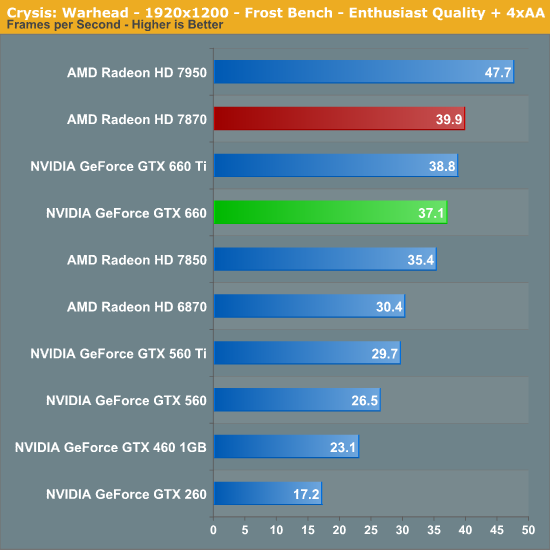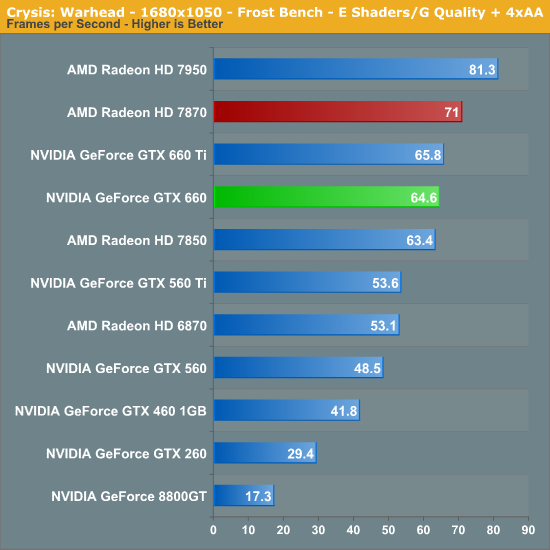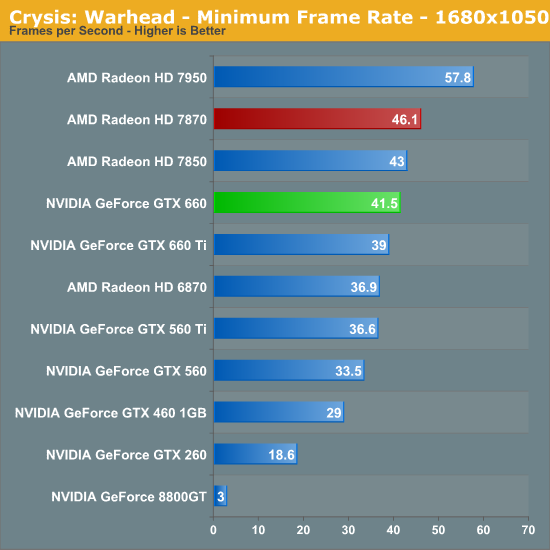The NVIDIA GeForce GTX 660 Review: GK106 Fills Out The Kepler Family
by Ryan Smith on September 13, 2012 9:00 AM ESTCrysis: Warhead
Kicking things off as always is Crysis: Warhead. It’s no longer the toughest game in our benchmark suite, but it’s still a technically complex game that has proven to be a very consistent benchmark. Thus even four years since the release of the original Crysis, “but can it run Crysis?” is still an important question, and the answer continues to be “no.” While we’re closer than ever, full Enthusiast settings at a 60fps is still beyond the grasp of a single-GPU card.


Crysis has been a game that has consistently penalized Kepler for its lack of memory bandwidth. Nowhere was this more evident than the GTX 660 Ti, which thanks to its memory bus reduction took a significant hit. But as we alluded to in our introduction, there’s a corner case where the GTX 660 is going to be able to easily keep up with the GTX 660 Ti: ROP and memory bandwidth-bound situations. As a result we’re looking at the best case scenario for the GTX 660 when held up against the GTX 660 Ti, which sees the GTX 660 offer 95% of the performance of the GTX 660 Ti. Most games aren’t going to be like this, but in this one case the GTX 660 may as well be as good as the GTX 660 Ti as far as performance goes, which goes to prove just how bottlenecked Crysis is by memory bandwidth.
Looking at a more meaningful comparison, because the GTX 660 doesn’t take a memory bandwidth hit compared to the GTX 660 Ti, the resulting card is much more resource balanced which in turn impacts AMD’s ability to lead in this benchmark. AMD once again wins here with the 7870 taking the lead, but only by a relatively modest 7% margin. This is the first time we haven’t seen a comparable AMD card lead by a significant margin in this generation, which for NVIDIA is an improvement though still not a reversal of fortunes. At the same time however NVIDIA isn’t doing too much better than the 7850 here, beating AMD’s lesser 7800 by an even more modest 5%.
As for NVIDIA’s older cards, the generational performance gains are in-line with what we’ve already seen out of the other GTX 600 cards. Compared to the GTX 460 1GB for example, a card that launched over 2 years ago at the same price, performance is up by 50-60%. But unsurprisingly this is less than the performance gain going from the 8800GT to the GTX 460, a similar timeline jump that saw performance more than double. At the very least NVIDIA certainly has the 8800GT licked at this point (by nearly a factor of 4x), but this means they’re also at risk of perpetuating longer upgrade cycles for current GTX 460 owners.


Moving on to minimum framerates, our results are almost the same with one interesting twist: the GTX 660 is now beating the more expensive GTX 660 Ti. Why? As we mentioned earlier, because of the higher core clock the ROPs on the GTX 660 actually have a greater theoretical throughput than the ROPs on the GTX 660 Ti. Since we’re not seeing any other factors that would explain this difference (i.e. drivers) it’s very likely that the GTX 660’s faster ROPs are giving it the advantage here.
Though while this is enough to push the GTX 660 ahead of the GTX 660 Ti, it’s not improving the GTX 660’s situation relative to the 7800 series at all. The GTX 660 is still closer to the 7850 than it is the 7870 here.










147 Comments
View All Comments
Amgal - Friday, September 14, 2012 - link
A little off topic, but does anandtech have an article explaining TU's, SMXes, ROPs, shader clock, etc- basically explaining the new age graphics card architectures? I really enjoy their informative articles, and am having some trouble finding one on that area that isn't littered with incomprehensible computer science macroes. Thanks.pattycake0147 - Friday, September 14, 2012 - link
If the majority of cards available for sale have custom coolers, why are noise measurements taken for only the reference card? Especially when you've stated that you have custom cards in the lab.Jad77 - Friday, September 14, 2012 - link
but shouldn't AMD be releasing their next generation sometime soon?Patflute - Friday, September 14, 2012 - link
Months from now.rarson - Friday, September 14, 2012 - link
Can we please stop pretending that Nvidia's supply issues are anybody's fault but their own? Is it just a coincidence that Fermi and Kepler both were huge, horrible misfires or is it possible that Nvidia has struggled to design things that actually yield decently? Can we stop ignoring the fact that AMD has had an entire lineup of 28nm parts since March (you know, like 2 months before Kepler ever appeared in reasonable quantities)? Yeah, 28nm IS constrained, but other companies are still putting out parts. Nvidia can't put out parts because they have to throw them away. They're eating the wafers (they must be eating a lot of them if it took them this long to bring out a $300 part).I hope Nvidia can pull it together because at this rate, AMD's going to start launching a generation ahead of them (they already have all of the console business).
CeriseCogburn - Thursday, November 29, 2012 - link
nVidia dropped it production purchased spots, so you amd fanboys could blow giant dollars on nearly unavailable amd crap overpriced crashing non pci-e3 gen compliant video card trashyou did so
Well not you, but you know what I mean
Then nVidia released and 2 days before amd "magically" had supply in the channels.
If you're too stupid to know that - well - sorry since it's obvious
Then amd crashed it's prices 4 times, and amd fanboys were left raped
Then amd fired 10% more and now 15% more
I hope the amd golden parachutes for the criminal executives pleased you
What's your guess on the amd buyout rumors ?
My guess is that 3G of ram you fools tried to lie about having an advantage with the totaled and incapable gpu choking on dirt below it at frame rates no Skyrim player could possibly stand, won't be recieving "driver updates" for that "glorious future" when "new games" that "can make use of it" "become available" !
right fan boy ?
RIGHT
LOL
Have a nice cry, err I meant day.
Lepton87 - Friday, September 14, 2012 - link
This card is obviously slower than 7870.http://tpucdn.com/reviews/MSI/GTX_660_Twin_Frozr_I...
Just look at performance summaries from other sites. But the most glaring flaw of this review is NOT comparing it to OC'ed AMD cards. After OC even 7850 is going to obliterate this overpriced card with almost no clock headroom.
Lepton87 - Friday, September 14, 2012 - link
Unfortunately Anandtech is playing favourites. It's the only site that I know that has somewhat decent reputation that just couldn't admit that 7970GE is simply a faster card than GTX680 and now this....CeriseCogburn - Thursday, November 29, 2012 - link
Oh come on quarky, Crysis Warhead and Metro first on every review doesn't do it for you ?The alphabet here goes A for amd first, then C, the jumps to M, for amd , again and again.
Why so sour, because amd is almost toast ?
CeriseCogburn - Thursday, November 29, 2012 - link
100%, vs 103%, at a single resolution, the 1920x1200, when 1920x1080 shows another story, and the 7850 is down low at 85%.LOL - yeah amd fanboy, you sure are telling this amd fanboy site..
Can we count how CRAPPY amd drivers are ? Can we count no adaptive v-sync on amd crap cards, can we count no 4 monitors out of the box on amd cards, can we count no auto overclocking, can we count amd slashing it's staff and driver writers aka catalusy maker issues ?
Can we count any of that, or should we just count 3% ? LOL
Oh wait fair and above it all amd fanboy, I know the answer...
We will just count 3 more frames per 100 frame rate, at a single resolution, at your single link, and ignore everything else.
LOL
Thank you for your support.